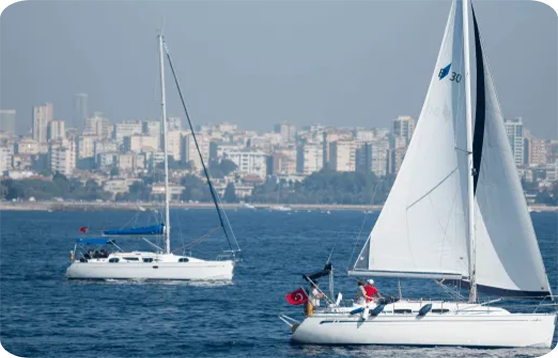Boating can be a challenging recreational especially when heading off the coast. Boat owners need to be well aware of the risks posed in the waters they are entering and more importantly, have the knowledge and skills to handle those risks to ensure the safety of themselves, their passengers and their boat. One of the greatest risks and one that has been highlighted lately is that of crossing sandbars or coastal bars. In early March a 4.8 metre half cabin boat capsized while attempting to cross the sandbar at Merimbula on the NSW South Coast and three occupants were fortunate to survive the incident.
If you are planning to enjoy boating on the coast and especially where a river meets the coast, then you need to know how to handle crossing bars and you need to have a boat that is suitable for the waters. State-based maritime and marine authorities provide extensive information on the topic which we have referred to in presenting this information.
What is a coastal bar and where do they occur?
A coastal bar is more commonly referred to as a sandbar as it is essentially made of sand. These bars are shallow and shifting banks of sands which are usually found where a river or estuary meets the open water. Coastal bars are very common at the river entrance and boat operators may need to cross the bar, under certain weather conditions, to access the open waters.
Coastal bars typically have large and breaking waves and strong currents. Both aspects can be deceptive in regard to the risk and dangers they present.
Preparing to crossing a coastal bar
- Authorities advise that crossing bars can be extremely dangerous as the channels for access through can be frequently changing. Tides and weather both play a part and need to be studied in detail. Rule 1 that authorities advise is not to attempt a bar crossing before seeking out local information and knowledge and preferably experience. If you are visiting an area, ask the locals and heed their advice.
- Check the conditions before you start out and be well-prepared to change your mind about the crossing and postpone or cancel your plans until conditions improve. Authorities advise to engage the assistance of an experienced boat operator to cross the bar prior to attempting this yourself.
- Tide and weather affect coastal bars so it is critical that you check both before heading out. An outgoing tide will increase the swell. Some state authorities have webcams of their coastal bars which provide live feeds of conditions. Bookmark the link on your phone for quick reference and use the BOM app for weather and tide updates.
- Preparing your boat and your passengers to cross a bar is critical. All occupants should be wearing the appropriate life jackets. Expect that waves will be breaking across the bow or the boat so check all hatches and openings are secure and watertight and drainage channels are free and working and secure all loose items.
- You will need to work the throttle to adjust speed during the crossing and have good steering capabilities. So check these are all in good working order and that your boat is extremely sea worthy. The boat should be built to withstand a level of impact from the waves you will encounter.
Crossing in a safe manner
- While you are strongly advised to seek instruction and training from experts, here are a few guidelines we have sourced from maritime authorities to give you an indication of why seeking professional assistance is important.
- It’s considered to be safer to cross a bar on the incoming tide.
- Avoid outgoing tide crossings wherever possible as this is considered the most dangerous periods.
- Once you’ve started you need to continue as attempting to turnaround mid-crossing poses extreme risk, especially of being swamped.
- When heading out, approach the waves head-on or as close to that angle as possible while avoiding the wave breaking onto the boat.
- Control your speed, avoiding hitting the waves at a high speed which can cause a boat to become airborne and loss of control.
- Watch and wait for a lull as you idle to the wave break and when a flat area opens, increase speed to go through and continue this same process through the next sets, backing off on power before you meet the next wave. Repeat until you are through the entire break area and have crossed the bar.
- When returning, the conditions may have changed and observation will be required. Waiting for improving conditions or a tide change may be required.
- Refer to video resources to upskill your knowledge and capabilities around coming back in safely.
Refer to your state maritime authority for a guide to sandbars in the area you intend to use your boat and take the time to read their advice and watch the videos provided.
Securing the Right Boat
One of the keys to safely crossing coastal bars and in fact, safely navigating through any particular waterway is to have the right boat. If you want to head into waters that your current boat is not suited to take on, talk to Jade Boat Loans about finance to buy one that is suitable.
With our cheap interest rates on boat loans, affording that bigger or stronger boat than you currently own may be a more realistic possibility than you think.
- Use our boat loan calculator to convert the boat purchase price to repayment estimates.
- Include the cost of all the required safety equipment you may need in the loan.
- Apply using our online application form or apply over the phone
Ensure every boating outing is a safe experience by referring to advice from authorities and having the boat to suit the conditions.
To apply for a cheap boat loan call Jade Boat Loans 1300 000 003
DISCLAIMER: THE INFORMATION IN THIS ARTICLE IS PREPARED SOLELY FOR INFORMATION PURPOSES AND IS NOT INTENDED AS FINANCIAL ADVICE OR AS THE SOLE BASIS FOR MAKING FINANCIAL DECISIONS. THOSE REQUIRING ADVICE SHOULD CONSULT A FINANCIAL ADVISOR. NO LIABILITY IS ACCEPTED FOR ANY MISREPRESENTATIONS OF PRODUCTS, POLICIES AND INFORMATION OR ERRORS IN THE CONTENT AS REFERRED FROM OTHER SOURCES.

 "
alt="">
"
alt="">